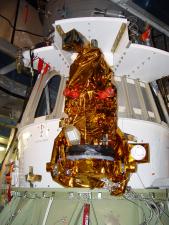When it came to exploring and operating in space, GTRI Engineer Thom Davis was helping develop big new ideas by thinking small. Under an Air Force Research Laboratory project at Kirtland Air Force Base, Florida, Davis led a group experimenting with microsatellites — relatively small and low-cost alternatives to full-size unmanned space vehicles.
Microsatellites are designed to operate autonomously, eliminating the need for ground-based guidance and control and potentially extending satellites' capabilities. They carry an inherent redundancy, multi-mission capability, and a significantly lower cost because they can be mass-produced. It may also be possible to deploy clusters of microsatellites, orbiting in formation, and electronically networked to act as a single large radar-antenna aperture.
Early experimentation involved a successful launch of a test vehicle weighing 68 pounds and measuring about three feet by 18 inches. The XSS-10 spacecraft was carried aloft via a second-stage, modified Boeing Delta II rocket. It carried a computer programmed with specific navigation and maneuvering operations and gathered real-time data to autonomously update the software's algorithms once orbit was achieved.
The XSS-10 mission provided a critical first step toward autonomous satellite operations. Subsequent ongoing research is examining issues including modeling, simulation, and signal processing.

